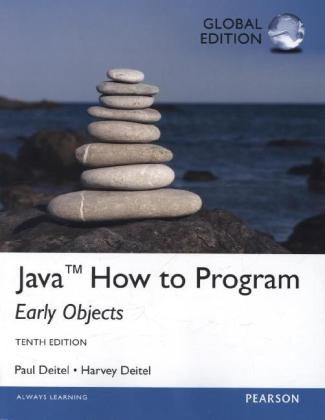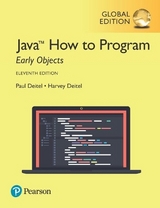
Java How To Program (Early Objects), Global Edition
Pearson Education Limited
978-1-292-01819-5 (ISBN)
- Titel erscheint in neuer Auflage
- Artikel merken
The Deitels' groundbreaking How to Program series offers unparalleled breadth and depth of object-oriented programming concepts and intermediate-level topics for further study. Java How to Program (Early Objects), Tenth Edition, teaches programming by presenting the concepts in the context of full working programs and takes an early-objects approach
MyProgrammingLab for Java How to Program (Early Objects) is a total learning package. MyProgrammingLab is an online homework, tutorial, and assessment program that truly engages students in learning. It helps students better prepare for class, quizzes, and exams-resulting in better performance in the course-and provides educators a dynamic set of tools for gauging individual and class progress.
Teaching and Learning Experience
This program presents a better teaching and learning experience-for you and your students.
Personalize Learning with MyProgrammingLab: Through the power of practice and immediate personalized feedback, MyProgrammingLab helps students fully grasp the logic, semantics, and syntax of programming.
Teach Programming with the Deitels' Signature Live Code Approach: Java language features are introduced with thousands of lines of code in hundreds of complete working programs.
Introduce Objects Early: Presenting objects and classes early gets students "thinking about objects" immediately and mastering these concepts more thoroughly.
Keep Your Course Current: This edition can be used with Java SE 7 or Java SE 8, and is up-to-date with the latest technologies and advancements.
Facilitate Learning with Outstanding Applied Pedagogy: Making a Difference exercise sets, projects, and hundreds of valuable programming tips help students apply concepts.
Support Instructors and Students: Student and instructor resources are available to expand on the topics presented in the text.
Print Book Chapters
Chapter 1, Introduction to Computers, the Internet and Java
Chapter 2, Introduction to Java Applications; Input/Output and Operators
Chapter 3, Introduction to Classes, Objects, Methods and Strings
Chapter 4, Control Statements: Part 1; Assignment, ++ and - Operators
Chapter 5, Control Statements: Part 2; Logical Operators
Chapter 6, Methods: A Deeper Look
Chapter 7, Arrays and ArrayLists
Chapter 8, Classes and Objects: A Deeper Look
Chapter 9, Object-Oriented Programming: Inheritance
Chapter 10, Object-Oriented Programming: Polymorphism and Interfaces
Chapter 11, Exception Handling: A Deeper Look
Chapter 12, GUI Components: Part 1
Chapter 13, Graphics and Java 2D
Chapter 14, Strings, Characters and Regular Expressions
Chapter 15, Files, Streams and Object Serialization
Chapter 16, Generic Collections
Chapter 17, Java SE 8 Lambdas and Streams
Chapter 18, Recursion
Chapter 19, Searching, Sorting and Big O
Chapter 20, Generic Classes and Methods
Chapter 21, Custom Generic Data Structures
Chapter 22, GUI Components: Part 2
Chapter 23, Concurrency
Chapter 24, Accessing Databases with JDBC
Chapter 25, JavaFX GUI: Part 1
Online Chapters
Chapter 26, JavaFX GUI: Part 2 (PSR-Per Software Release)
Chapter 27, JavaFX Graphics and Multimedia (PSR-Per Software Release)
Chapter 28, Networking
Chapter 29, Java Persistence Architecture (JPA)
Chapter 30, JavaServer (TM) Faces Web Apps: Part 1
Chapter 31, JavaServer (TM) Faces Web Apps: Part 2
Chapter 32, REST-Based Web Services
Chapter 33, ATM Case Study, Part 1: Object-Oriented Design with the UML
Chapter 34, ATM Case Study, Part 2: Implementing an Object-Oriented Design
Print Book Appendices
Appendix A, Operator Precedence Chart
Appendix B, ASCII Character Set
Appendix C, Keywords and Reserved Words
Appendix D, Primitive Types
Appendix E, Using the Debugger
Online Appendices
Appendix F, Using the Java API Documentation
Appendix G, Creating Documentation with javadoc
Appendix H, Unicode
Appendix I, Formatted Output
Appendix J, Number Systems
Appendix K, Bit Manipulation
Appendix L, Labeled break and continue Statements
Appendix M, UML 2: Additional Diagram Types
Appendix N, Design Patterns
| Verlagsort | Harlow |
|---|---|
| Sprache | englisch |
| Maße | 181 x 234 mm |
| Gewicht | 1670 g |
| Themenwelt | Schulbuch / Wörterbuch |
| Informatik ► Software Entwicklung ► Objektorientierung | |
| ISBN-10 | 1-292-01819-4 / 1292018194 |
| ISBN-13 | 978-1-292-01819-5 / 9781292018195 |
| Zustand | Neuware |
| Haben Sie eine Frage zum Produkt? |
aus dem Bereich



